TennisOne Lessons Getting More Rhythm into Your Game Doug King Perhaps the most elusive aspect of the game of tennis is the elegant flow of movement in rhythmic coordination with the constantly changing tempo of the ball. There is both a total awareness of self consisting of the subtle shifts of body parts to produce a perfectly orchestrated stroking movement. At the same time there is an equally acute sense of the external elements of time and space – the ball, the court, the opponent, the intention - that ultimately determine the shape of that stroke.
The entire game is full of movements, both internal and external. Internally the breath, the heartbeat, even the movement of thoughts can be considered in a framework of rhythmic cadences. The external movements of the ball and its punctuated bounces off the surfaces of both court and racquet act as the dominant bass rhythm. The various touches of shoe to court - light taps to screeching squeals to sustained slides create another definite rhythm. The flow of the racquet like an ocean wave, starting with a gentle roll and ending in a climactic swish of strings through air and ball – somehow transfixed by the ball and yet, at the same time, oblivious to it. Yes, the goal is to get in tune with these rhythms – for therein lies the key to turning these unruly elements into coordinated, graceful, flowing play. The Stroke Rhythm Model An obvious goal in improving your tennis game is developing proper stroking patterns. These patterns must be repeatable, flexible, and eventually unconscious. There are various ways to develop correct stroke patterning which we call models or systems – all of them useful. Typically we start with a positional approach such as how to grip, how to stand at ready, where to be at the turn, where to contact, and where to finish. Another model is a rhythm model where we develop a sense of the timing between the various positions of the stroke. When we watch the top players we see quite a variation in the various positions including grips, turns, and follow-throughs. However, we see very little variation in the rhythmic character of good players. Whether it is Federer whipping a forehand crosscourt or Davenport driving a two-handed backhand down the line, all these shots follow a basic rhythmic formula. Although not all strokes have the same rhythmic tempo, the game can be broken down into some major stroking rhythmic patterns: groundstrokes, volleys, and serves. In all of these cases the key to developing rhythm is to find critical stroke reference positions and phases and then to overlay a rhythmic scheme to tie those positions/phases into a more repeatable stroking pattern. If the body can eventually translate the positions into a rhythmic flow of movement, then the stroke will be more fluid. If the stroke is more fluid, it is more adaptable, requires less mental and physical effort, and is ultimately more powerful and precise. We will use audible counts to rehearse the stroke pattern without the ball and then try to sustain a rhythmic sensibility while in play with the ball.
Groundstrokes: Three Beat Rhythm For most groundstrokes (especially topspin) I suggest a three count rhythmic beat. These three beats are defined by the three stroke positions or phases; one is the initial reaction to the ball, two is a flow into a hitting position (the “slot”), and three is the acceleration phase or the hit (“pulling the trigger”). Of course the most obvious place to start with when we talk about rhythm is the feet. In fact this is the dominant theme, but we will also tie in the movements of the arms along with the feet to create a fully integrated stroking pattern. Beat One: The Turn The first beat is characterized by the recognition and reaction to the ball – the split step and the spring out of the split and into the turn. As a note, I like to count the split step as a preliminary rhythmic beat. For the split step I like to say “Touch” followed almost immediately by the count “ONE” which is the turn. “Touch – ONE” almost becomes a single beat. This beat is quick and dominated by the light, rapid spring of the feet. It may even be explosive in the event of a wide shot. In terms of the arms there is relatively little action here. There is a gripping action that occurs in this beat where one must orient to the correct grip for the stroke required, but the arms stay relatively compact to the body. Beat One is felt in the core of the body, the feet and shoulders should be the only things felt at this time. In this phase, it is important to keep the arm(s) “heavy” and stable and let them stay in unison with the turning action of the shoulder. Many mistakes occur at this juncture as there is a common urge to swing the arm around in the backswing. When this happens it results in a loss of control of the racquet position and timing through the rest of the swing. Two handed strokes help alleviate this problem as they reduce the amount of extension and swing away from the body of the arms. When the arm stays in the proper stable, heavy feel and in sync with the rolling action of the shoulder, the stroke is said to maintain proper “shape.”
Beat Two: Drop and Fall into the Slot Beat two is a flowing movement of the trunk and upper arm(s) combined with adjusting steps. It is circular in nature and is a much more sustained or drawn out tempo. Whereas Beat One (“Touch – ONE”) is staccato in tempo, Beat Two is legato (slow) and you want to let it drawl out. It is the critical phase of building power and position into the racquet leading up to the final strike. It includes a bit more shoulder turn usually but it is dominated by a relaxed falling of the arm and relaxing of the wrist. On the downward phase, the knees bend, the arm(s) fall, and the wrist relaxes, dropping the arm and racquet into the final position below and inside the ball.
This position is commonly called “the slot” and it is the point at which the hit is triggered. In the slot there is a relaxed “re-gathering” of the arm just prior to going into the hit. It is important to find this relaxed positioning of the hand rather than simply committing to hitting the ball from the top of the backswing. You do not want to interrupt the flow of the movement as you drop into the slot (it must be continuous) but you want to stay relaxed and flexible so that you can both focus on the ball and make subtle, intuitive adjustments to the ball as you go into the hit. Beat Three: Pulling the Trigger
Beat Three is the hitting phase of the rhythm. It is quick and accented. It is the acceleration phase and is often called “pulling the trigger.” Releasing the hit starts in the legs with a push up and is accompanied by a shoulder turn and a lift of the arm. All of these occur in rapid succession to create a blurring flow of accelerated arm movement through the ball. The racquet is swept up and through the ball to impart desired spin, pace, and direction.
Federer increases acceleration by breaking the stroke off into the lower arm. The “feel” of the stroke has shifted from the upper arm in Beat Two to the lower arm in Beat Three.
Often times the energy of the swing is transferred from the upper arm and shoulder area of Beat Two to the lower arm and elbow on Beat Three. This can amplify the acceleration phase of the stroke through contact. This is typical of many of the modern pro forehands to attain additional spin and speed. Conclusion Whatever your grip, whatever type or degree of spin you put on the ball, your stroke should be able to move with a minimum of stress and effort. Of course, the eventual goal in your stroking patterns is to develop a swing that requires no conscious, deliberate thought but simply flows in sync with the oncoming ball. Developing rhythm in your stroke is critical to maintaining a fluid, repeatable stroke. Once you develop your key body and racquet positions in the turn, slot, and finish, practice to develop a fluid rhythm pattern that starts with a quick turn, a relaxed drop, and a smooth acceleration to finish.
This can start with "shadow stroking" accompanied with a preset 1-2-3 cadence that you count out with the stroke (remember; 1 quick - 2 slow - 3 quick), and include drop-hitting, backboard practice, ball machine practice - anything that allows you to reproduce a consistent rhythmic stroke that is fluid and balanced. Ultimately the goal is to produce a consistent contact that is free of tension and hesitation and which instead smoothly accelerates with a confident, unimpeded movement through contact. Put this rhythm practice into your routine and eventually your stroke will be as simple as 1-2-3. Your comments are welcome. Let us know what you think about Doug King's article by emailing us here at TennisOne.
Doug is one of the country's foremost tennis teaching innovators. Founder of Acceleration Tennis, a revolutionary teaching system, King is leading the way in reinterpreting the traditional tennis model. For more information on Acceleration Tennis please email Doug King at dking@meadowood.com. |

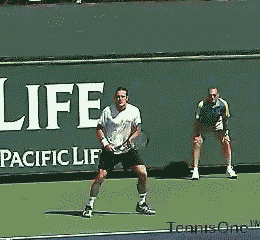
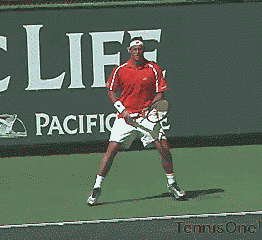
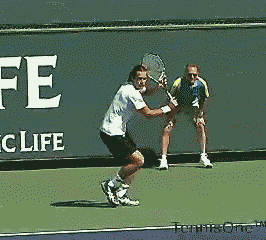
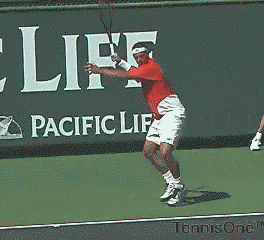
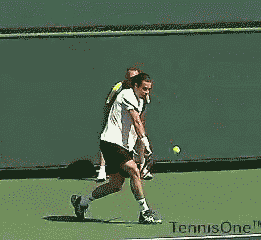
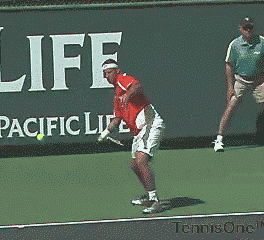
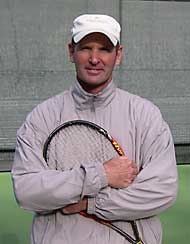
 Doug King studied with legendary tennis coach Tom Stow and was a
former California State Men's Singles Champion
and the former number one men's player of Northern California.
Doug King studied with legendary tennis coach Tom Stow and was a
former California State Men's Singles Champion
and the former number one men's player of Northern California.